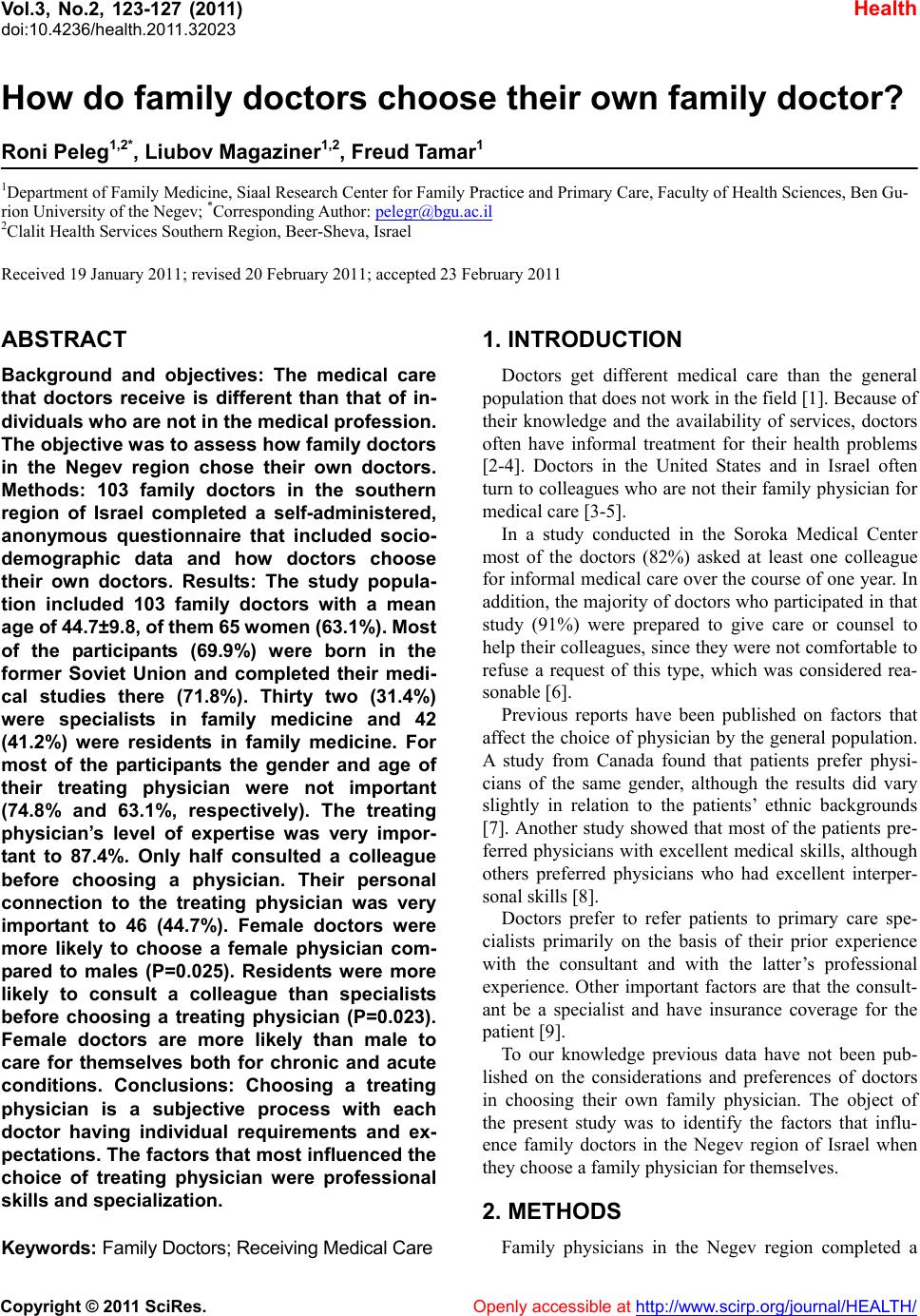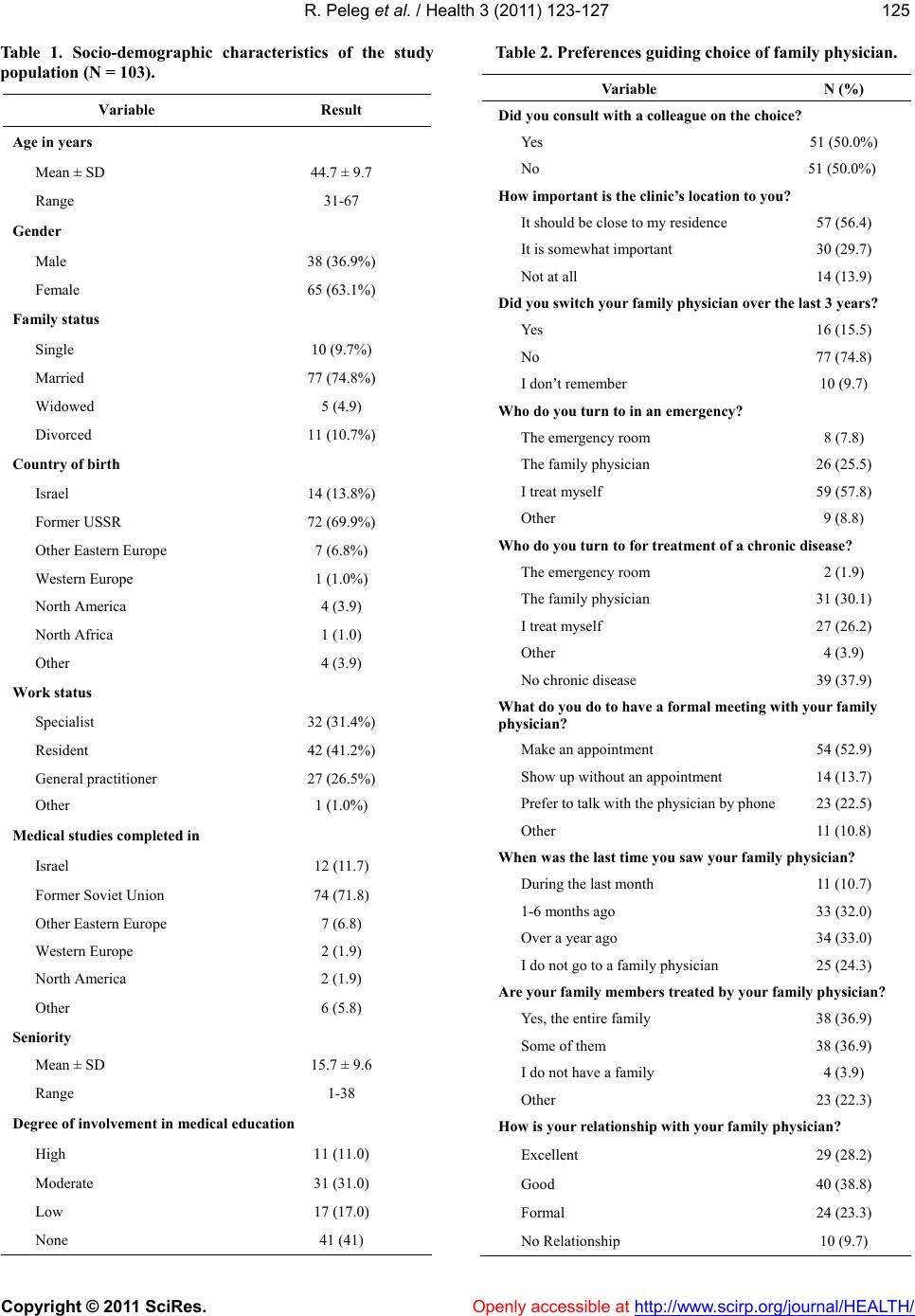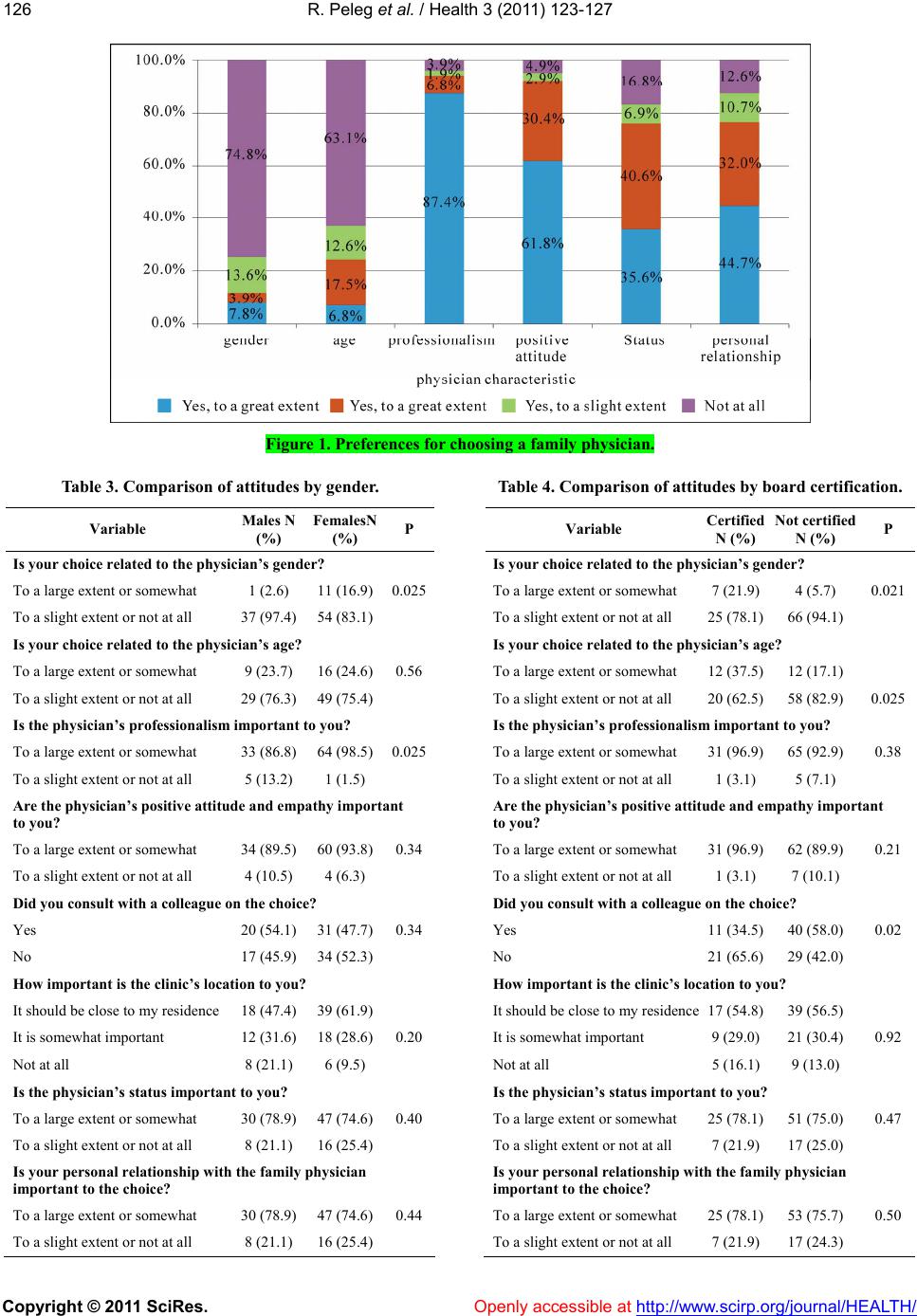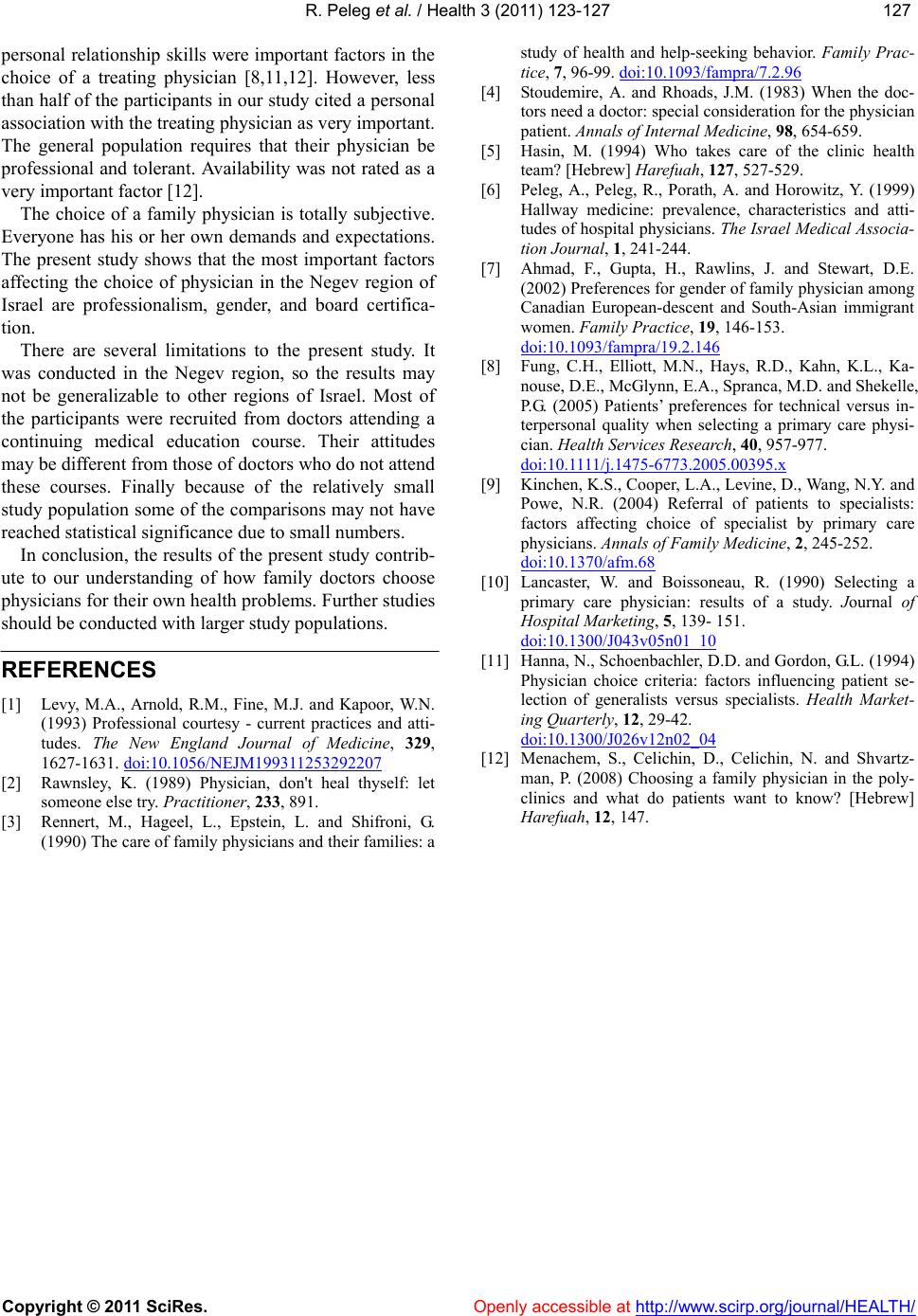Paper Menu >>
Journal Menu >>
 Vol.3, No.2, 123-127 (2011) Health doi:10.4236/health.2011.32023 Copyright © 2011 SciRes. Openly accessible at http://www.scirp.org/journal/HEALTH/ How do family doctors choose their own family doctor? Roni Peleg1,2*, Liubov Magaziner1,2, Freud Tamar1 1Department of Family Medicine, Siaal Research Center for Family Practice and Primary Care, Faculty of Health Sciences, Ben Gu- rion University of the Negev; *Corresponding Author: peleg r @ b gu .ac.il 2Clalit Health Services Southern Region, Beer-Sheva, Israel Received 19 January 2011; revised 20 February 2011; accepted 23 February 2011 ABSTRACT Background and objectives: The medical care that doctors receive is different than that of in- dividuals who are not in the medical profession. The objective was to assess how family doctors in the Negev region chose their own doctors. Methods: 103 family doctors in the southern region of Israel completed a self-administered, anonymous questionnaire that included socio- demographic data and how doctors choose their own doctors. Results: The study popula- tion included 103 family doctors with a mean age of 44.7±9.8, of them 65 women (63.1%). Most of the participants (69.9%) were born in the former Soviet Union and completed their medi- cal studies there (71.8%). Thirty two (31.4%) were specialists in family medicine and 42 (41.2%) were residents in family medicine. For most of the participants the gender and age of their treating physician were not important (74.8% and 63.1%, respectively). The treating physician’s level of expertise was very impor- tant to 87.4%. Only half consulted a colleague before choosing a physician. Their personal connection to the treating physician was very important to 46 (44.7%). Female doctors were more likely to choose a female physician com- pared to males (P=0.025). Residents were more likely to consult a colleague than specialists before choosing a treating physician (P=0.023). Female doctors are more likely than male to care for themselves both for chronic and acute conditions. Conclusions: Choosing a treating physician is a subjective process with each doctor having individual requirements and ex- pectations. The factors that most influenced the choice of treating physician were professional skills and specialization. Keywords: Family Doctors; Receiving Medical Care 1. INTRODUCTION Doctors get different medical care than the general population that does no t work in the field [1]. Becaus e of their knowledge and the availability of services, doctors often have informal treatment for their health problems [2-4]. Doctors in the United States and in Israel often turn to colleagues who are not th eir family physician for medical care [3-5]. In a study conducted in the Soroka Medical Center most of the doctors (82%) asked at least one colleague for informal medical care over the course of one year. In addition, the majority of doctors who participated in that study (91%) were prepared to give care or counsel to help their colleagues, since they were not comfortable to refuse a request of this type, which was considered rea- sonable [6]. Previous reports have been published on factors that affect the choice of physician by the general population. A study from Canada found that patients prefer physi- cians of the same gender, although the results did vary slightly in relation to the patients’ ethnic backgrounds [7]. Another study showed that most of the patients pre- ferred physicians with excellent medical skills, although others preferred physicians who had excellent interper- sonal skills [8]. Doctors prefer to refer patients to primary care spe- cialists primarily on the basis of their prior experience with the consultant and with the latter’s professional experience. Other important factors are that the consult- ant be a specialist and have insurance coverage for the patient [9]. To our knowledge previous data have not been pub- lished on the considerations and preferences of doctors in choosing their own family physician. The object of the present study was to identify the factors that influ- ence family doctors in the Negev region of Israel when they choose a family physician for them selves. 2. METHODS Family physicians in the Negev region completed a  R. Peleg et al. / Health 3 (2011) 123-127 Copyright © 2011 SciRes. Openly accessible at http://www.scirp.org/journal/HEALTH/ 124 two-part self-administered, anonymous questionnaire. The first part included sociodemographic information and the second part related to factors that affected the choice of a family physician for their own health prob- lems. The questionnaires were distributed to a conven- ience sample of 103 doctors participatin g in a con tinuing medical education program. All the questionnaires were completed satisfactorily. The data were analyzed with the SPSS software, ver- sion 17. T-tests were conducted for continuous variables and chi-square tests were conducted for discrete vari- ables. All tests were two-tailed with the significance level set at P < 0.05. 3. RESULTS 3.1. Socio-Demographic Characteristics of the Study Population The study population included 103 family doctors with a mean age of 44.7 ± 9.8, 65 of them are women (63.1%). Thirty two (31.4%) were experts in family medicine and 42 (41.2%) were residents in family medi- cine, 69.9% were born in the former Soviet Union (71.8%). The socio-demographic characteristics of the study participants are shown in [Table 1]. 3.2. Preferences for Choosing a Family Physician [Table 2 and Figure 1] The majority of participating doctors did not consider gender (74.8%) or age (63.1%) important factors in choosing a family physician for themselves. A vast ma- jority (87.4%) considered the professional level of the physician to be very important. Only half of the partici- pants consulted a colleague at the time of the decision and only 46 (44.7%) considered a personal connection with the physician to be an important consideration. Sixty six doctors (61.8%) cited a positive attitude and empathy as an important consideration. 3.3. Association between Gender and Choice of Treating Physician [Table 3] Female doctors were more likely to prefer a female family physician for themselves than males (P = 0.025). Female also lent greater importance to the physician’s professional level than males. 3.4. Association of Specialist or Resident Status and Choice of Treating Physician [Table 4] Non-specialist doctors (residents and GPs) were more likely to consult colleagues on the choice of a treating ysician than specialists (P = 0.02). There were no statis- tically significant differences in any of the other charac- teristics, although non-specialis ts consider ed the age an d gender of the treating physician more important than specialist. Family doctors involved in medical education were less likely to consult a colleague about the choice of treating physician than those not involved in it (P = 0.025). The type of medical problem (emergency, acute, or chronic) did not affect the choice of a treating physi- cian. 4. DISCUSSION Israeli doctors, just like the rest of the Israeli popula- tion, can choose their treating physician freely. Family physicians practice holistic therapy based on the bi- opsychosocial model. Family doctors are more familiar with the healthcare system than the general population and choose their treating physician with this advantage. In addition, they usually hav e a personal connectio n with the one they choose as their personal physician. The general population does not usually have access to the information that doctors do [10]. In this study we assessed the factors that affect doc- tors’ choice of a treating physician in the so uth ern Negev region of Israel. The results of the study can add to our understanding of how doctors approach treatment of their own health pro bl e ms. The vast majority of participants considered the phy- sician’s professional level to be of prime importance. This finding is similar to those of other studies [8,11]. Doctors prefer to refer their own patients to primary care consultants based on the latter ’s professional experience and the doctor’s previous experience with the specific consultant. Other factors that affect the decision are spe- cialization status and insurance coverage for the patient [9]. Family doctors often prefer to turn directly to spe- cialist consultants, particularly in the areas of general surgery and gynecology, to get a second opinion [6]. Prior to reaching a decision on a treating physician general practitioners and residents in family medicine are more likely than experts in family medicine to con- sult a colleague. In contrast, doctors who are involved in medical education are less likely to consult a colleague than those who are not involved in medical education. The majority of participants did not attribute impor- tance to the gender or age of the physician they chose to treat them. In a study conducted in Canada doctors were more likely to choose a ph ysician of their own gender to treat them [7]. In our study women were more likely to choose a female physician than men. Several previous studies, including one conducted in Israel, found that a positive attitude, empathy, and good  R. Peleg et al. / Health 3 (2011) 123-127 Copyright © 2011 SciRes. Openly accessible at http://www.scirp.org/journal/HEALTH/ 125125 Table 1. Socio-demographic characteristics of the study population (N = 103). Variable Result Age in years Mean ± SD 44.7 ± 9.7 Range 31-67 Gender Male 38 (36.9%) Female 65 (63.1%) Family status Single 10 (9.7%) Married 77 (74.8%) Widowed 5 (4.9) Divorced 11 (10.7%) Country of birth Israel 14 (13.8%) Former USSR 72 (69.9%) Other Eastern Europe 7 (6.8%) Western Europe 1 (1.0%) North America 4 (3.9) North Africa 1 (1.0) Other 4 (3.9) Work status Specialist 32 (31.4%) Resident 42 (41.2%) General practitioner 27 (26.5%) Other 1 (1.0%) Medical studies completed in Israel 12 (11.7) Former Soviet Union 74 (71.8) Other Eastern Europe 7 (6.8) Western Europe 2 (1.9) North America 2 (1.9) Other 6 (5.8) Seniority Mean ± SD 15.7 ± 9.6 Range 1-38 Degree of involvement in medical education High 11 (11.0) Moderate 31 (31.0) Low 17 (17.0) None 41 (41) Table 2. Preferences guiding choice of family physician. Variable N (%) Did you consult with a colleague on the choice? Yes 51 (50.0%) No 51 (50.0%) How important is the clinic’s location to you? It should be close to my residence 57 (56.4) It is somewhat important 30 (29.7) Not at all 14 (13.9) Did you switch your family physician over the last 3 years? Yes 16 (15.5) No 77 (74.8) I don’t remember 10 (9.7) Who do you turn to in an emergency? The emergency room 8 (7.8) The family physician 26 (25.5) I treat myself 59 (57.8) Other 9 (8.8) Who do you turn to for treatment of a chr onic disease? The emergency room 2 (1.9) The family physician 31 (30.1) I treat myself 27 (26.2) Other 4 (3.9) No chronic disease 39 (37.9) What do you do to have a formal meeting with your family physician? Make an appointment 54 (52.9) Show up without an appointment 14 (13.7) Prefer to talk with the physician by phone 23 (22.5) Other 11 (10.8) When was the last time you saw your family physician? During the last month 11 (10.7) 1-6 months ago 33 (32.0) Over a year ago 34 (33.0) I do not go to a family physician 25 (24.3) Are your family members treated by your family physician? Yes, the entire family 38 (36.9) Some of them 38 (36.9) I do not have a family 4 (3.9) Other 23 (22.3) How is your relationship with your family physician? Excellent 29 (28.2) Good 40 (38.8) Formal 24 (23.3) No Relationship 10 (9. 7)  R. Peleg et al. / Health 3 (2011) 123-127 Copyright © 2011 SciRes. Openly accessible at http://www.scirp.org/journal/HEALTH/ 126 Figure 1. Preferences for choosing a family physician. Table 3. Comparison of attitudes by gender. Variable Males N (%) FemalesN (%) P Is your choice related to the physician’s gender? To a large extent or somewhat 1 (2.6) 11 (16.9)0.025 To a slight extent or not at all 37 (97.4) 54 (83.1) Is your choice related to the physician’s age? To a large extent or somewhat 9 (23.7) 16 (24.6)0.56 To a slight extent or not at all 29 (76.3) 49 (75.4) Is the physician’s professionalism important to you? To a large extent or somewhat 33 (86.8) 64 (98.5)0.025 To a slight extent or not at all 5 (13.2) 1 (1.5) Are the physician’s positive attitude and empathy important to you? To a large extent or somewhat 34 (89.5) 60 (93.8)0.34 To a slight extent or not at all 4 (10.5) 4 (6.3) Did you consult with a colleague on the choice? Yes 20 (54.1) 31 (47.7)0.34 No 17 (45.9) 34 (52.3) How important is the clinic’s location to you? It should be close to my residence 18 (47.4) 39 (61.9) It is somewhat important 12 (31.6) 18 (28.6)0.20 Not at all 8 (21.1) 6 (9.5) Is the physician’s status important to you? To a large extent or somewhat 30 (78.9) 47 (74.6)0.40 To a slight extent or not at all 8 (21.1) 16 (25.4) Is your personal relationship with the family physician important to the choice? To a large extent or somewhat 30 (78.9) 47 (74.6)0.44 To a slight extent or not at all 8 (21.1) 16 (25.4) Table 4. Comparison of attitudes by board certification. Variable Certified N (%) Not certified N (%) P Is your choice related to the physician’s gender? To a large extent or somewhat 7 (21.9) 4 (5.7) 0.021 To a slight extent or not at all 25 (78.1) 66 (94.1) Is your choice related to the physician’s age? To a large extent or somewhat 12 (37.5) 12 (17.1) To a slight extent or not at all 20 (62.5) 58 (82.9) 0.025 Is the physician’s professionalism important to you? To a large extent or somewhat 31 (96.9) 65 (92.9) 0.38 To a slight extent or not at all 1 (3.1) 5 (7.1) Are the physician’s positive attitude and empathy important to you? To a large extent or somewhat 31 (96.9) 62 (89.9) 0.21 To a slight extent or not at all 1 (3.1) 7 (10.1) Did you consult with a colleague on the choice? Yes 11 (34.5) 40 (58.0) 0.02 No 21 (65.6) 29 (42.0) How important is the clinic’s location to you? It should be close to my residence 17 (54.8) 39 (56.5) It is somewhat important 9 (29.0) 21 (30.4) 0.92 Not at all 5 (16.1) 9 (13.0) Is the physician’s status important to you? To a large extent or somewhat 25 (78.1) 51 (75.0) 0.47 To a slight extent or not at all 7 (21.9) 17 (25.0) Is your personal relationship with the family physician important to the choice? To a large extent or somewhat 25 (78.1) 53 (75.7) 0.50 To a slight extent or not at all 7 (21.9) 17 (24.3)  R. Peleg et al. / Health 3 (2011) 123-127 Copyright © 2011 SciRes. Openly accessible at http://www.scirp.org/journal/HEALTH/ 127127 personal relationship skills were important factors in the choice of a treating physician [8,11,12]. However, less than half of the participants in our stud y cited a personal association with the treating ph ysician as v ery importan t. The general population requires that their physician be professional and tolerant. Availability was not rated as a very important factor [12]. The choice of a family physician is totally subjective. Everyone has his or her own demands and expectations. The present study shows that the most important factors affecting the choice of physician in the Negev region of Israel are professionalism, gender, and board certifica- tion. There are several limitations to the present study. It was conducted in the Negev region, so the results may not be generalizable to other regions of Israel. Most of the participants were recruited from doctors attending a continuing medical education course. Their attitudes may be different from those of doctors who do not attend these courses. Finally because of the relatively small study population some of the comparisons may not have reached statistical significance due to small numbers. In conclusion, the resu lts of the present study contrib- ute to our understanding of how family doctors choose physicians for their own health problems. Further studies should be conducted with larger study populations. REFERENCES [1] Levy, M.A., Arnold, R.M., Fine, M.J. and Kapoor, W.N. (1993) Professional courtesy - current practices and atti- tudes. The New England Journal of Medicine, 329, 1627-1631. doi:10.1056/NEJM199311253292207 [2] Rawnsley, K. (1989) Physician, don't heal thyself: let someone else try. Practitioner, 233, 891. [3] Rennert, M., Hageel, L., Epstein, L. and Shifroni, G. (1990) The care of family physicians and their families: a study of health and help-seeking behavior. Family Prac- tice, 7, 96-99. doi:10.1093/fampra/7.2.96 [4] Stoudemire, A. and Rhoads, J.M. (1983) When the doc- tors need a doctor: special consideration for the physician patient. Annals of Internal Medicine, 98, 654-659. [5] Hasin, M. (1994) Who takes care of the clinic health team? [Hebrew] Harefuah, 127, 527-529. [6] Peleg, A., Peleg, R., Porath, A. and Horowitz, Y. (1999) Hallway medicine: prevalence, characteristics and atti- tudes of hospital physicians. The Israel Medical Associa- tion Journal, 1, 241-244. [7] Ahmad, F., Gupta, H., Rawlins, J. and Stewart, D.E. (2002) Preferences for gender of family physician among Canadian European-descent and South-Asian immigrant women. Family Practice, 19, 146-153. doi:10.1093/fampra/19.2.146 [8] Fung, C.H., Elliott, M.N., Hays, R.D., Kahn, K.L., Ka- nouse, D.E., McGlynn, E.A., Spranca, M.D. and Shekelle, P.G. (2005) Patients’ preferences for technical versus in- terpersonal quality when selecting a primary care physi- cian. Health Services Research, 40, 957-977. doi:10 .1111/j .1475-6773.2005.00395.x [9] Kinchen, K.S., Cooper, L.A., Levine, D., Wang, N.Y. and Powe, N.R. (2004) Referral of patients to specialists: factors affecting choice of specialist by primary care physicians. Annals of Family Medicine, 2, 245-252. doi:10.1370/afm.68 [10] Lancaster, W. and Boissoneau, R. (1990) Selecting a primary care physician: results of a study. Journal of Hospital Marketing, 5, 139- 151. doi:10.1300/J043v05n01_10 [11] Hanna, N., Schoenbachler, D.D. and Gordon, G.L. (1994) Physician choice criteria: factors influencing patient se- lection of generalists versus specialists. Health Market- ing Quarterly, 12, 29-42. doi:10.1300/J026v12n02_04 [12] Menachem, S., Celichin, D., Celichin, N. and Shvartz- man, P. (2008) Choosing a family physician in the poly- clinics and what do patients want to know? [Hebrew] Harefuah, 12, 147. |

